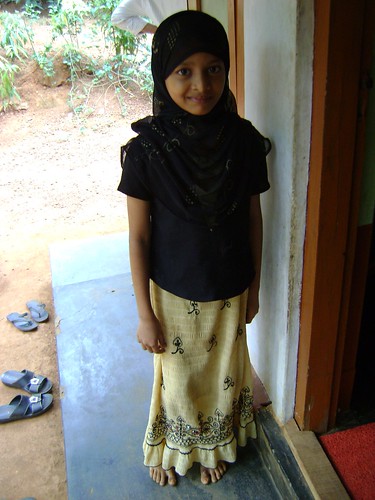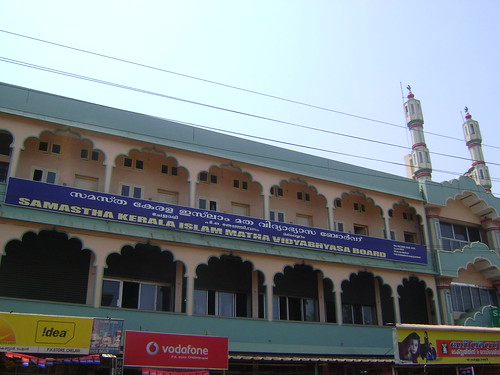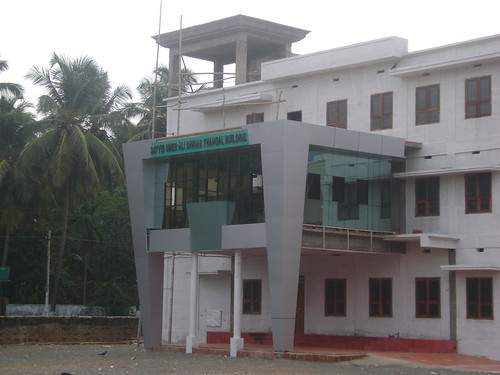By Kashif-ul-Huda, TwoCircles.net
TCN Malabar series: Part 4
The system of Islamic education must have started at the same time as the first few masajid were established in Kerala. This system evolved over a thousand years period and even though for a century there is great emphasis on modern education, the Islamic education system survives and with some new trends shows that it continues to thrive.
Religious education among Muslims of Malabar can be divided into three distinct styles- Othupalli, Dars, and Madrasas.
Othupalli or Maktab: Not quite different from their counterparts in North India or any Muslim countries, Othupallis are single teacher schools set up in neighborhood mosques. The imam of the mosque also acts as the teacher of the Othupalli and gives basic Islamic education to the children of the area. Students here are taught surahs and duas from Quran and learn to read Arabic. They will also learn how to pray and other basic Islamic teachings are imparted.
This system survives and now serves as centres of Islamic education for students attending schools where they learn modern subjects. Classes under Othupallis are held either before or after regular school hours to accommodate school going children.

A student of Othupalli
Dars syestem: Kerala’s dars system is unparalleled anywhere. Its scheme is genius in how it utilizes the resources available in the community for the propagation of knowledge. As you may have noticed in previous articles of this TCN series on Malabar, all the mosques profiled here have a second (or more) floor. The purpose of the second floor is not only to hold the overflow of worshippers on special prayers days, but it also serves as a place where a group of students can be lodged and be comfortable. The first floor of the mosque doubles as a classroom during non-prayer times.
The other interesting feature of the Dars system is that the education is free to the students. They get free education from the imam of the masjid, and their lodging is free on the top floors of the building. These students are also considered guests of the locality where the masjid is situated and each house of the area is assigned a student and they are responsible for his food. In return for food, the student teaches the young children of the house. This way, the best use of limited resources is ensured and in the process, young generations get served with quality education.

Alathurpadi Juma Masjid & Dars in Melmuri village
Darses continues to this day in almost all the masajid that I visited during my Kerala stay. One of the places had about 50 students managed by one teacher and an assistant. Though very miniscule, the library is properly catalogued and a reference desk was on the premises. Probably one of the most modern Dars, it also possesses three computers where they learn basic computer literacy and learn to use various popular software.
Dars system being independent and small scale, served the community well until recently. Muslim leaders were quick to realize that this system needs to be improved with the changing times. On one hand they improved the standardization of teaching in Othupallis and Darses while improving the conditions of teachers serving in these centuries old community institutions. On the other hand, big madrasas were established that have specialized teachers and a well-developed curriculum.
Madrasas: In 1911, A.M. Koyakunhi started Madanul Uloom Madrasa in Cannanore. Around the same time Maulana Chalilakath Kunhahamed Haji started higher education in his madrasa and called it Darul Uloom Arabic College. This madrasa introduced for the first time many new subjects and used modern teaching methods.
The dars education has been systematized under the unified syllabus called the Wafi course which is run by the Samastha Kerala Jamiyathul Ulema. There are some Islamic Colleges affiliated to this system.
There are some Islamic colleges run by the Tabligh-i Jamat which follow the North Indian system of Alim, Hafiz and Mufti courses.
The Islamiya College at Shanthapuram in Malappuram founded half a century ago was a bold step in the education system combining Islamic and modern subjects. It includes journalism, Islamic finance, political science, philosophy, comparative religion etc. The college was upgraded as Islamic University recently which was inaugurated by renowned scholar Dr Sheikh Yusuful Qaradawi.
The traditional Sunni organizations which did not give much importance to women education have now come forward with novel ideas like the Majmaul Islami catering for religious and modern education for girls.
To improve the condition of the Othupallis and Dars systems of education, one of the organizations Samastha Kerala Jamiyyathul Ulama (SKJU) started a madrasa board called Samastha Kerala Islam Matha Vidyabhyasa Board (All Kerala Muslim Educational Board) in 1951. I visited their headquarters which is near Kozhikode, it is buzzing with activities. Their publication department was busy in producing a number of magazines for different sections of the society. Elsewhere, a special camp was organized for the madrasa examiners to help them learn about different tajweed (proper pronunciation of Arabic words) rules.

Board officials informed me that they have 8777 madrasas registered to their board in which 1,035,000 students are learning. Most of these are Othupallis but some may be Dars. They have one hundred thousand teachers working in these madrasas. The salary of the teachers and all expenses of the madarasa are met by the villages where these madrasas are situated. The Board takes care of the pension of the teachers when they retire and also deposits money in their welfare funds. The Board itself is funded by exam fees. Examinations are conducted at 5th, 7th, 10th, and 12th grade levels. Till fifth grade level madrasas are co-educational. It just so happens that in 2009 girls have ranked first in all the four levels for which examinations are held.
The Board also has 106 madrasa inspectors who are constantly on the move and continuously check for the quality of education being taught in board affiliated madrasas, hence the need for their special camp, as we saw earlier. In recent years the Board has spread its wings and now it has 384 madrasas in Karnataka, 38 in Tamil Nadu, 12 in Andaman Islands, 11 in United Arab Emirates, 3 in Oman, and 4 in Malaysia. Board officials informed me that their text books are being translated in Urdu but could not tell if there are any Urdu medium madrasas that seek affiliation with the Board. There is opposition to Central Madrasa Board by Ulama in North India but nothing like what Samastha Kerala Islam Matha Vidyabhyasa Board is doing was ever set up there. Similarly, there exists Samastha Kerala Sunni Vidyabhyasa Board, the Kerala Nadvathul Mujahideen, the Nadvathul Mujahideen Kerala, the Dakshin Kerala Islam Matha Vidyabhyasa Board and Jamaat-e-Islami also have their own madrasa board in Kerala. There are many other minor madrasa boards unattached to any of the above madrasa boards of religious organizations like the Hidayathul Muslimeen Sabha which was established in Manjeri in Malappuram district in 1897.
Other important difference between the North and South is that here Ulama have set up a system that does not compete with modern education but supplements it with proper Islamic education and moral training. A pass out from the 12th grade level madrasa examinations can choose to continue his modern education or religious education depending on his interest.

Jamiya Nooriya

Darul Huda
Pass outs from the Dars system are eligible for admissions to Darul Uloom Deoband, Nadvatul Ulama Lucknow or Jamia Nizamiya Hyderabad. Jamia Nooriya in Malappuram, established in 1963, provides two years higher education in Shafi Fiqh for those who want to remain in Kerala. Graduates of this prestigious institution are called Moulavi Fazil Faizy and are in high demand as teachers, khateebs, qazis, etc.
On the other end of Islamic education is Darul Huda, a relatively new institution with a fresh vision. Established in 1986, Darul Huda has set up a number of feeder institutions from where it takes the brightest students after completion of their primary schooling and takes them through 12 years of grueling Islamic and modern education. While learning finer points of religion they also master subjects like Social Studies, History, and English.
Led by dynamic and affable vice-principal, Maulana Bahauddin who is from Kerala but had some of his education in North India, Darul Huda is a modern facility. Darul Huda graduates have gone on to do PhD from Jawaharlal Nehru University, Jamia Milia Islamia, Jamia Hamdard, and Aligarh Muslim University. Talking to TwoCircles.net, Maulana Bahauddin said that the aim is to produce “new generation of scholars who can work in this new age and new world.” While it is too early to say whether Darul Huda is a successful experiment, it is an idea that was long overdue. And why only Social Sciences, Ulama should learn about Natural Sciences and the day is not far when we can produce world class scientists who are guided by a strong desire to help humanity and conduct themselves with strict ethical codes that Islamic moral education can provide.
The system of Islamic education has come a long way since the early days of Othupallis system. But rather than replace the old system with something new and unique, brilliant minds of Kerala have built upon their ancient heritage improving them in the process and providing a way for the future. This is definitely something that Muslims from all over the world can learn from.
Links:
http://www.samastha.net/
http://www.darulhuda.com/
(With inputs from Najiya O. in Kerala)

